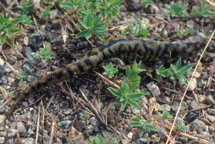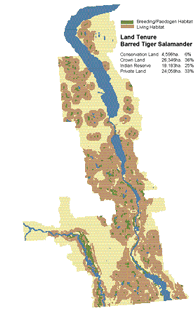|
Habitat Atlas for Wildlife at Risk
Tiger Salamander
Ambysoma tigrinum

Adult Salamander
|

- Length: 14 to 22 cm, with a tail up
to half the body length.
- Rounded, blunt-nosed head with small, protruding
eyes.
- Highly variable in pattern: bold mottling of greenish,
yellowish, cream or olive tan patches on a brown
or black background; patches are large, regular and
often
interconnected.
- Short, unwebbed toes which taper to points.
- Larvae have large heads and huge gills that are
swept back along the body.
Tiger Salamander Land Tenure
Map - PDF version
Status:
British Columbia Red List
Special Significance
The Tiger Salamander is one of the few salamanders
that is adapted to desert climates. Tiger Salamanders
are at risk in British Columbia because of their
small population, limited distribution and the rapid
development of their habitat for human use. Many
remaining ponds and lakes that provide suitable breeding
habitat for these threatened salamanders are on privately
owned land. Landowners can help to ensure the continued
survival of these salamanders by conserving wetlands,
excluding livestock and game fish stocking from breeding
ponds, and retaining adjacent natural areas of shrub-grasslands.
Distribution
- In British Columbia, Tiger Salamanders have been found at low
to mid elevations from Grand Forks west to Keremeos and as far north
as Peachland.
- Most of the British Columbia population is in the Okanagan
Valley south of Okanagan Falls; ponds in the White
Lake areas are especially productive.
Habitat
- Breed in warm ponds, shallow lake edges and temporary pools (often
salty or alkaline) and slow moving creeks; breeding
sites are adjacent to grassland foraging habitat.
- Hatchlings and larvae live in aquatic weeds, under
logs or in organic sediment in shallow water.
- Adults forage in semi-arid grasslands, open forests
and riparian areas.
- Adults hibernate in deep, fine-soiled grasslands,
meadows, coniferous forests, riparian areas
and permanent waterbodies.
- Mammal burrows and rotting logs provide hibernating
sites.
Reproduction
- After the first spring rains, salamanders migrate from their winter
burrows to nearby bodies of water.
- Breeding occurs from March through August.
- Courtship includes nudging and tail lashing which prompts
the male to deposit a sperm packet that the female
retrieves with her vent.
- Females lay up to 120 eggs in water less than 1 meter
deep; eggs are usually attached to stones, plants
or debris underwater.
- Gilled aquatic larvae hatch in two to three weeks;
most metamorphose into adults in two to three months,
developing lungs and losing their gills and tail fins.
- Terrestrial adults migrate from breeding areas to hibernating
sites in August and September.
- Maximum lifespan is 20 years.
Food Habits
- Larvae eat small aquatic mites, worms, insects, tadpoles and smaller
salamander larvae.
- Adults eat earthworms, insects, baby mice, frogs, snails
and slugs.
Interesting Facts
- Ambystoma means 'blunt mouth'; tigrinum means 'like a tiger',
it reflects the bright yellow-and-back striping of some adults.
- Tiger Salamanders can withstand alkaline water that
would pickle most animals.
- Some larvae do not metamorphose into terrestrial adults;
they retain their gills and mate in the aquatic
environment; these forms are known as paedogens, neotenes, waterdogs
or mudpuppies, growing
up to 32 cm in length and living for 25 years.
- If ponds dry up or contain little food, some salamander
larvae will become cannibal morphs, developing
greatly enlarged mouths and large teeth and preying on members of
their own species.
Threats
- Livestock can trample banks of ponds and
lakes, destroying salamander burrows and the
surrounding protective vegetation. Hoof imprints
along the pond edges create small puddles which
dry up and kill eggs and larvae within them
- Breeding habitat is lost through filling
and draining ponds and wetlands
- Introduced game fish can compete with salamanders
for food as well as eat salamander eggs and
larvae
- Poisoning lakes to kill coarse fish also
kills aquatic salamanders
- Extensive land development has degraded
or eliminated riparian areas and grasslands
adjacent to water bodies
- Vehicle road kills during migration to and
from breeding areas
- Unscreened irrigation intake lines can kill
salamanders
Management Considerations
- Fence ponds and lakes to exclude livestock
- Maintain water levels of ponds and irrigation
reservoirs whenever possible
- Create ponds to compensate for loss of natural
breeding habitat
- Protect riparian areas and shrub-grasslands
to provide migration corridors and feeding
areas
- Do not stock salamander breeding ponds or
lakes with game fish
- Ensure irrigation intake lines are screened
- Contact your local British Columbia Ministry
of Water, Land and Air Protection if a Tiger
Salamander is sighted
|
References
1. Sarell, M., A. Bryan, N. Work and L. Dyer. 1996. Living in Nature
Series: Tiger Salamander (Ambystoma tigrinum). South Okanagan Similkameen
Stewardship Program.
2. Orchard, S.A. 1984. Amphibians and reptiles of British
Columbia; an ecological review. Ministry of Forests. Victoria, British
Columbia.
3. Corkran, C.C. and C. R. Thoms. 1996. Amphibians
of Oregon, Washington and British Columbia: a field identification
guide. Lone Pine Publishing. Vancouver, British Columbia 175pp.
|